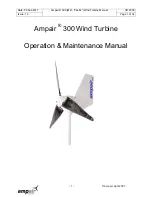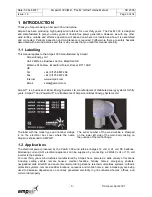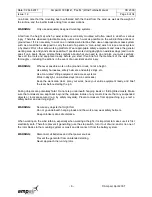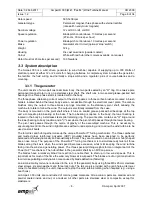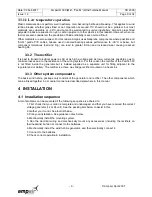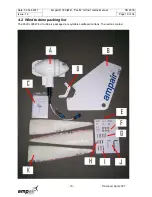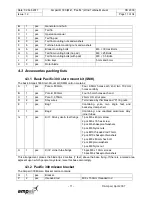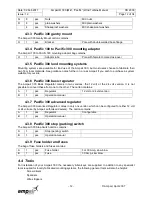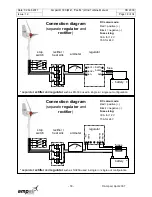
Date: 02 Feb 2011
Ampair ® 300 (Mk1, “Pacific”) Wind Turbine Manual
CD 2300
Issue: 1.2
Page 5 of 34
- 5 -
© Ampair, April 2007
wind conditions and/or on a boat). It will swivel extremely unpredictably if the rotor is fitted but the tail is
not fitted.
WARNING:
Prevent the machine swivelling before entering the radius of the tail and rotor.
Wear a safety helmet before entering the radius of the tail and rotor.
2.2.2 Electrical dangers
The generator can produce open circuit voltages of up to 60 volts AC
rms
(12 volt version) and 120 volts
AC
rms
(24 volt version) in the wiring run between the turbine and rectifier. This is in no load operation with
the stop switch in the „on‟ position and
at a wind speed of approximately 30 miles per hour (approximately
15 metres per second).
WARNING:
Avoid handling bare open circuit wiring tails unless the rotor is physically stopped.
The charging current can reach up to 25 amps DC (12 volt version) and 12.5 amps DC (24 volt version) in
the wiring run between the rectifier and the battery (or load).
WARNING:
Install cables with sufficient cross sectional area of conductor. Inadequately sized cables
can rapidly overheat and create a fire hazard.
Install electrical components of sufficient voltage and current capacity at all points in the
circuit.
The battery must never be short circuited as the fault current is extremely high. If you do so there is a
serious risk that you will set the battery and cabling on fire, as well as releasing flammable and potentially
explosive gases (hydrogen) from the battery, and you will probably destroy the battery.
WARNING:
Never short circuit the battery.
Install fuses immediately adjacent to the wind turbine side of the battery (but not within
the battery compartment as the spark from a blowing fuse could ignite an explosive
hydrogen/air mixture).
Charging lead acid batteries releases flammable and potentially explosive hydrogen gas. Unsealed lead
acid batteries have vent caps to release this gas, which can detonate if it is mixed with air and a spark is
present (e.g. from a switch or a blowing fuse) or other ignition source (e.g. naked flame or hot surface
such as an exhaust).
WARNING:
Provide sufficient ventilation to the battery compartment.
Do not locate ignition sources within the battery compartment.
The regulators manufactured by Ampair are charge control regulators. However if you have chosen to
install (perhaps) cheaper and (definitely) less effective dump regulators then you should be aware that
these can become very hot. They must not be mounted on flammable surfaces.
WARNING:
Do not install dump regulators on or near flammable materials.
2.2.3 Dangers when mounting the wind turbine or working at height
Very careful attention must be given to the strength and integrity of the mounting. As a minimum this
should be capable of withstanding a peak horizontal load of 50 kg (100 lbs). If mounting the wind turbine

